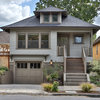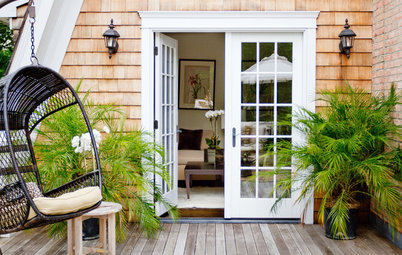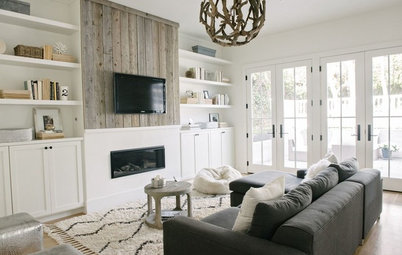How to Choose a Ceiling Fan for Comfort and Style
Houzz pros share what fan size to buy, what blade angle to look for and which type works with your ceiling height
Annie Thornton
June 10, 2019
Houzz Editorial Staff
Ceiling fans make great additions to the home year-round. They cool us down in summer and warm us up in winter. New features and technologies mean they’re more energy-efficient than ever, and design updates have led to some pretty stylish models.
Personal preference plays a big role when buying a ceiling fan, and it’s always helpful to discuss your needs with a professional. To help you get started, check out the following tips from experts on how to choose a ceiling fan, including determining the right ceiling fan size and the optimal hanging distance from the ceiling.
Personal preference plays a big role when buying a ceiling fan, and it’s always helpful to discuss your needs with a professional. To help you get started, check out the following tips from experts on how to choose a ceiling fan, including determining the right ceiling fan size and the optimal hanging distance from the ceiling.
How to Choose a Ceiling Fan
Pick the right ceiling fan size for your room. Size is important. If your ceiling fan is too small for your room, it won’t move air efficiently or effectively. If it’s too big, it could create the feeling of being in a wind tunnel.
Room size is the main factor for determining what size ceiling fan you need, although ceiling height can affect it as well. (With taller ceilings, you may want to size up or use multiple fans, as the fan will need to circulate more air.) The following ceiling fan size guide from the American Lighting Association can help you determine which size is right for you.
Find a pro to help you choose a ceiling fan
Pick the right ceiling fan size for your room. Size is important. If your ceiling fan is too small for your room, it won’t move air efficiently or effectively. If it’s too big, it could create the feeling of being in a wind tunnel.
Room size is the main factor for determining what size ceiling fan you need, although ceiling height can affect it as well. (With taller ceilings, you may want to size up or use multiple fans, as the fan will need to circulate more air.) The following ceiling fan size guide from the American Lighting Association can help you determine which size is right for you.
- Rooms up to 75 square feet: 36 inches wide or smaller
- Rooms up to 144 square feet: 36 to 42 inches wide
- Rooms about 225 square feet: 50 to 54 inches wide
- Rooms larger than 225 square feet: an oversize fan or multiple ceiling fans
Find a pro to help you choose a ceiling fan
It’s important to remember that these size guides are suggestions.
“Aesthetics and homeowner preference play a big role in using these guidelines,” says Allyson Mokhtarei, owner of Alcott & Bentley, a lighting and ceiling fan showroom in Louisville, Kentucky.
“Some of today’s industrial multiblade fans have an oversized look, at 84 to 99 inches across, which is bigger than average,” says Caroline Halcovich, president of The Light House, a lighting and ceiling fan showroom in Palm Desert, California. Their style and airflow make them very popular.
Browse ceiling fans of all sizes
“Aesthetics and homeowner preference play a big role in using these guidelines,” says Allyson Mokhtarei, owner of Alcott & Bentley, a lighting and ceiling fan showroom in Louisville, Kentucky.
“Some of today’s industrial multiblade fans have an oversized look, at 84 to 99 inches across, which is bigger than average,” says Caroline Halcovich, president of The Light House, a lighting and ceiling fan showroom in Palm Desert, California. Their style and airflow make them very popular.
Browse ceiling fans of all sizes
Consider the number and angle of the blades. With today’s models, there isn’t necessarily a right number of blades for a ceiling fan. It’s more of an aesthetic preference than a practical one.
When it comes to airflow, the motor and the blade pitch are most important. The American Lighting Association recommends a 12- to 15-degree blade pitch for optimum air movement, although plenty of companies offer ceiling fans with steeper blade angles. “The steeper the pitch, the more air the fan can churn, like a mixer or blender,” Halcovich says.
“Where the number of blades does come into play is with some of the very large eight-blade fans that have been introduced to the market in the last couple years,” Mokhtarei says. “The goal of these fans is to gently circulate air in the room, rather than to create a cooling breeze.”
When it comes to airflow, the motor and the blade pitch are most important. The American Lighting Association recommends a 12- to 15-degree blade pitch for optimum air movement, although plenty of companies offer ceiling fans with steeper blade angles. “The steeper the pitch, the more air the fan can churn, like a mixer or blender,” Halcovich says.
“Where the number of blades does come into play is with some of the very large eight-blade fans that have been introduced to the market in the last couple years,” Mokhtarei says. “The goal of these fans is to gently circulate air in the room, rather than to create a cooling breeze.”
Get the height right. In general, experts say ceiling fans are at an optimal height for air movement when they are 8 to 9 feet above the ground (and at least 12 to 18 inches from the nearest wall). They can be higher, but the blades shouldn’t be less than 7 feet above the ground, for safety. Personal preference, in addition to ceiling height and slope, can affect the mounting type you choose for your ceiling fan.
- Ceiling fans for low ceilings. For ceilings less than 8 feet tall, choose a hugger or flush-mount ceiling fan. These fans mount next to the ceiling and help maintain the recommended minimum 7-foot clearance between ceiling and floor.
- Ceiling fans for standard-height ceilings. If the ceiling in your room is about 8 to 9 feet tall, you can most likely use the standard 3- to 5-inch long downrod, the pipe that connects the ceiling fan to the ceiling mounting and that comes with the fan.
- Ceiling fans for high ceilings. In high-ceiling rooms, longer downrods can bring the fan closer to the optimum hanging height. These extended rods sometimes come with the fan itself or are sold in kits. Lengths range from several inches to several feet. As the downrod gets toward the longer end of the spectrum, the potential for the ceiling fan to wobble increases. In the case of extra-high ceilings, you might choose to have multiple ceiling fans or to go with a larger fan.
- Ceiling fans for vaulted ceilings. Most ceiling fans can hang from sloped or vaulted ceilings that are less than 21 degrees, Mokhtarei says. Attachment kits can be bought for fans hanging on slopes that are steeper.
Buy a high-quality motor. A ceiling fan is a hardworking household appliance, and choosing one that will last starts with what’s inside. This is especially important for ceiling fans that will be used often and for hours at a time, such as in bedrooms or living rooms.
“Buyers need a high-quality motor with a reverse feature for year-round air circulation,” Mokhtarei says, as well as a limited lifetime warranty.
She adds that the answers to her clients’ most common questions — will the ceiling fan wobble, make noise, actually move air? — lie in the fan’s motor. “A good fan will be well-balanced and will not wobble or make noise, even after decades of use,” she says.
Mokhtarei and Halcovich both recommend buying a ceiling fan with a DC motor. “These motors use 70 percent less electricity than standard AC motors,” Mokhtarei says. They are quiet, often feature more speed options, have a reverse function on the remote and are generally faster to start, stop and change speed. “These small motors allow for a small fan body but tremendous power,” Halcovich says.
A motor with a reverse function enables your ceiling fan to be used year-round. In summer, blades should spin in a counterclockwise direction (at a higher speed, depending on the room temperature). This will blow air down onto you, creating a cooling wind-chill effect. Reversing the direction in winter so that blades spin clockwise will circulate warm air that has risen to the ceiling back down to the ground, keeping you warmer.
“Buyers need a high-quality motor with a reverse feature for year-round air circulation,” Mokhtarei says, as well as a limited lifetime warranty.
She adds that the answers to her clients’ most common questions — will the ceiling fan wobble, make noise, actually move air? — lie in the fan’s motor. “A good fan will be well-balanced and will not wobble or make noise, even after decades of use,” she says.
Mokhtarei and Halcovich both recommend buying a ceiling fan with a DC motor. “These motors use 70 percent less electricity than standard AC motors,” Mokhtarei says. They are quiet, often feature more speed options, have a reverse function on the remote and are generally faster to start, stop and change speed. “These small motors allow for a small fan body but tremendous power,” Halcovich says.
A motor with a reverse function enables your ceiling fan to be used year-round. In summer, blades should spin in a counterclockwise direction (at a higher speed, depending on the room temperature). This will blow air down onto you, creating a cooling wind-chill effect. Reversing the direction in winter so that blades spin clockwise will circulate warm air that has risen to the ceiling back down to the ground, keeping you warmer.
Accessories and Other Considerations
Lights. Ceiling fans are available with or without lights, depending on your needs. If the fan doesn’t come with lights, you can purchase a separate light kit attachment. “We recommend an LED light kit if there are no other overhead lights,” Mokhtarei says. “These light kits are low-profile, dimmable and emit a light output equivalent to 100-watt incandescent while only using 16 to 18 watts of electricity.”
Controls. Although ceiling cord pulls are still an option, wall-mounted or remote controls for ceiling fans have become mainstay features — in some instances, you don’t even need additional wiring for wall controls. “Many modern wall controls work via radio frequency, rather than being hard-wired, so they actually function like a remote control in your wall,” Mokhtarei says. Newer systems even use bluetooth technology, so fans can be controlled by an app on your phone.
Lights. Ceiling fans are available with or without lights, depending on your needs. If the fan doesn’t come with lights, you can purchase a separate light kit attachment. “We recommend an LED light kit if there are no other overhead lights,” Mokhtarei says. “These light kits are low-profile, dimmable and emit a light output equivalent to 100-watt incandescent while only using 16 to 18 watts of electricity.”
Controls. Although ceiling cord pulls are still an option, wall-mounted or remote controls for ceiling fans have become mainstay features — in some instances, you don’t even need additional wiring for wall controls. “Many modern wall controls work via radio frequency, rather than being hard-wired, so they actually function like a remote control in your wall,” Mokhtarei says. Newer systems even use bluetooth technology, so fans can be controlled by an app on your phone.
Outdoor ceiling fans. Ceiling fans are great additions to outdoor spaces as well, providing a cooling breeze in the heat of summer. When shopping for fans, you’ll see that they are rated to withstand dry, damp or wet conditions. For an outdoor space, such as under a porch or pergola, a ceiling fan that is rated for wet conditions is necessary. “Wet location fans can actually sit in the rain or get hosed off, since they are fully contained and their blades won’t warp or get damaged from the sun,” Halcovich says.
Ceiling fans rated for damp conditions can be used in bathrooms, carports or anywhere that may have moisture but no direct contact with water or the elements. You don’t want to use a ceiling fan rated for damp conditions outside.
Browse outdoor ceiling fans
Ceiling fans rated for damp conditions can be used in bathrooms, carports or anywhere that may have moisture but no direct contact with water or the elements. You don’t want to use a ceiling fan rated for damp conditions outside.
Browse outdoor ceiling fans
Installing your ceiling fan. Although a handy homeowner can probably swap out an old ceiling fan for a new one, working with a licensed electrician (one who specializes in fan installations) is always a good idea — especially if any new wiring needs to be done.
“Your fan specialist is able to perform the install quickly, identify problems and troubleshoot, balance the fan to prevent motor noise, and typically provide a 30-day installation warranty,” Halcovich says. The warranty is important, she adds, “because fans tend to settle in the first 30 days, and a good installer will make any adjustments needed during that time.”
Tell us: What tips helped you choose a ceiling fan? Share your thoughts and photos in the Comments.
More
6 Ways to Cool Off Without Air Conditioning
See inspiring rooms with ceiling fans
Find a pro to help you choose a ceiling fan
“Your fan specialist is able to perform the install quickly, identify problems and troubleshoot, balance the fan to prevent motor noise, and typically provide a 30-day installation warranty,” Halcovich says. The warranty is important, she adds, “because fans tend to settle in the first 30 days, and a good installer will make any adjustments needed during that time.”
Tell us: What tips helped you choose a ceiling fan? Share your thoughts and photos in the Comments.
More
6 Ways to Cool Off Without Air Conditioning
See inspiring rooms with ceiling fans
Find a pro to help you choose a ceiling fan
Related Stories
Doors
How to Secure Your French Doors
Read these 5 tips to make the classic glass doors in your home more safe and secure
Full Story
Kitchen Design
New This Week: 5 Kitchen Island Shapes You Haven’t Thought Of
Going a bit abstract with your island design can get you more room for seating, eating, prep and personal style
Full Story
Bathroom Design
How to Choose Your Bathroom Vanity Lighting
By Yanic Simard
Get tips on sconces, pendants, chandeliers, pot lights and LED strips — and find out where to place them
Full Story
Living Rooms
How to Decorate a Living Room: 11 Designer Tips
By Yanic Simard
Try a few of these living room design tips, and you’ll be on your way to creating a comfy space that reflects your style
Full Story
Shop Houzz
Contemporary Living Room
By Houzz
Streamline your design with furniture and decor from this collection
See Products
Bar Stools & Counter Stools
Up to 60% Off Bar and Counter Stools
By Houzz
Save on stylish seats that work with your kitchen counters
See Products
Garden Styles
9 Traditional Design Ideas for Your Garden
By Kate Burt
If modern landscapes leave you cold, here are ways to weave in classic character
Full Story
Outdoor Lounge Furniture
Outdoor Lounge Furniture With Free Shipping
By Houzz
Enjoy your patio with these picks
See Products
Housekeeping
Try These Bathroom Remodeling Ideas to Make Cleaning Easier
By Becky Harris
These fixtures, features and materials will save you time when it comes to keeping your bathroom sparkling
Full Story
Kitchen Design
How to Properly Light Your Kitchen Counters
By David Warfel
Discover these 6 professional tips for lighting your countertops and other kitchen workspaces
Full Story





























































I really dislike ceiling fans - they are dust collectors and hard to clean if you have high ceilings. We are in the process of having our entire interior repainted and will be taking down the builder's grade fan in our cathedral ceiling in the family room and replacing it with a less obtrusive simple fan - our present fan is bright brass and has 4 larger lights and I want something much simpler.
i understand the desire for a cool looking fan and there are lots of them out there i'd love to have, but if it doesn't perform, there's no point in having it. be sure to check the CFM.
Just like coopercj.....HAIKU FANS!!!!! They WORK!!! No shake, no shimmer, no rattle, no roll!!! Made in the USA!!!! Dependable, Gorgeous, Energy Efficient above and beyond! I'm just finishing my home and there will be one in every room!!! Had them in my other house. And their customer service....superb! Worth every penny! And no, I don't get a kickback from them.... I just prefer quality!!!https://www.bigassfans.com/for-home/